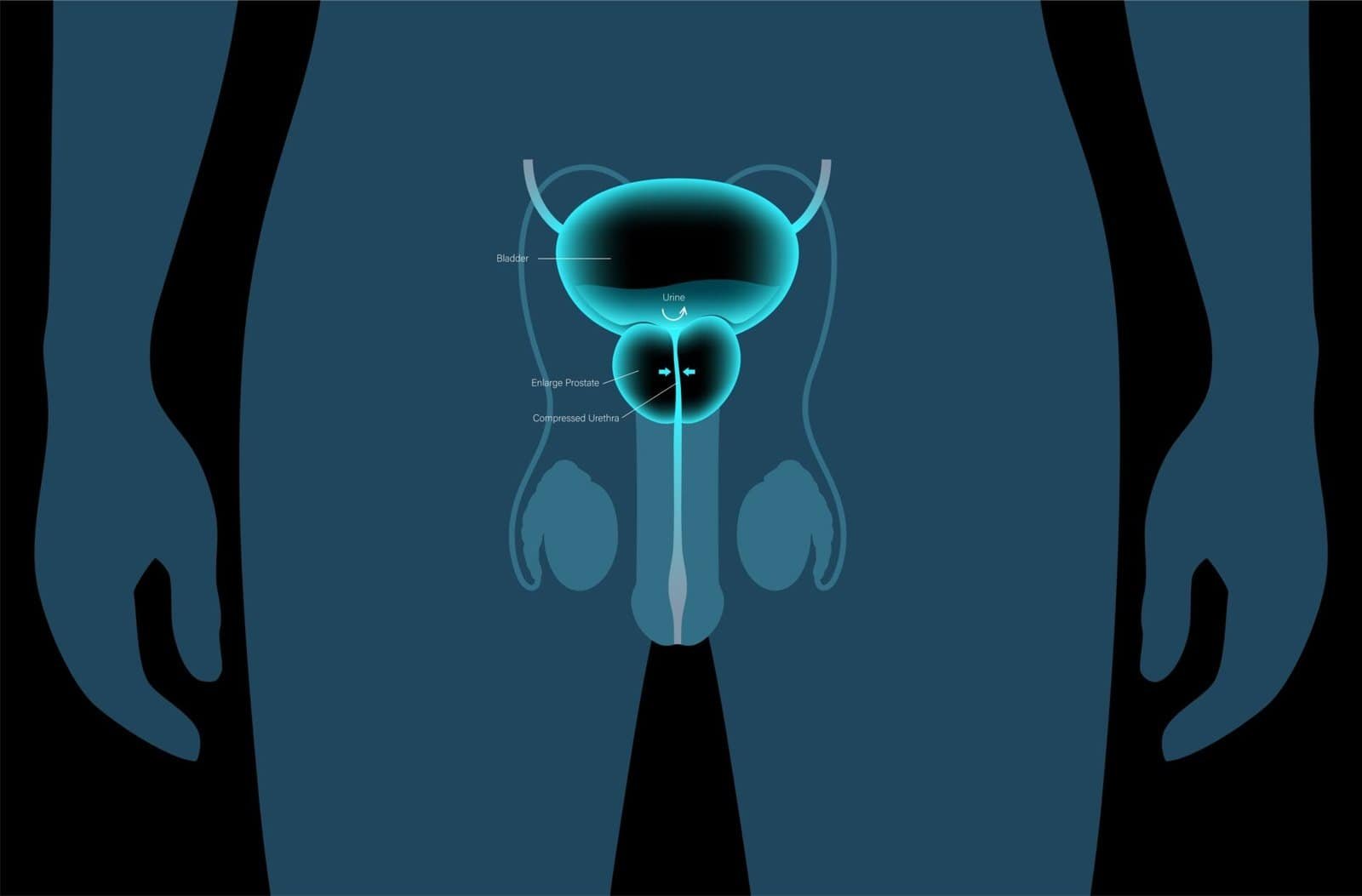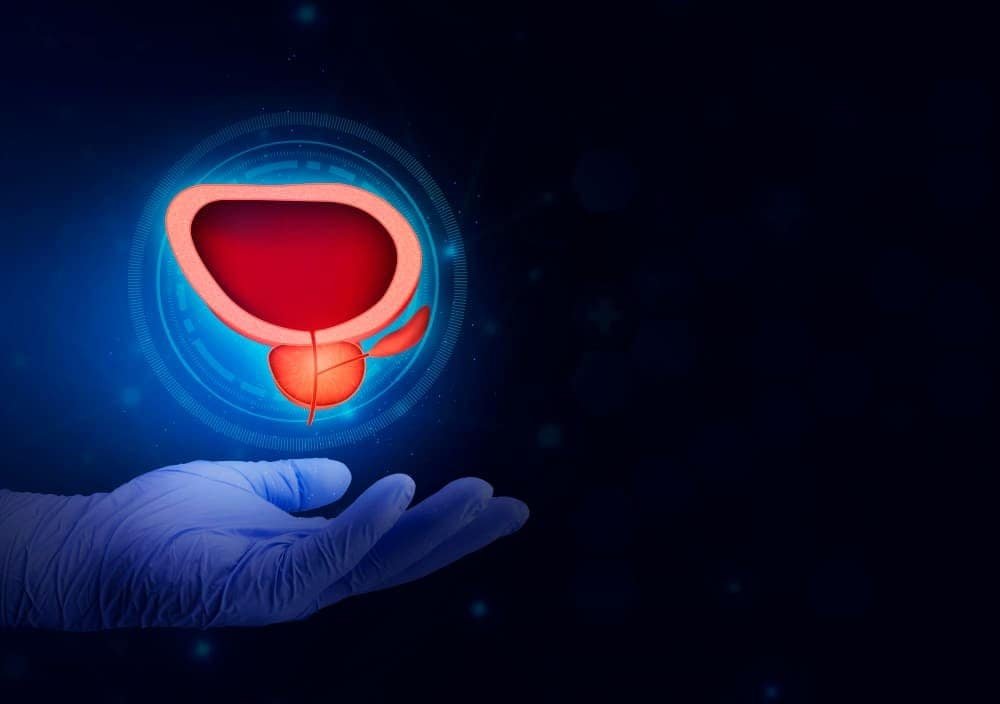Wondering how long prostate artery embolization lasts? This minimally invasive procedure treats benign prostatic hyperplasia (BPH), providing lasting relief from urinary symptoms and improving quality of life with a fast recovery. Discover the long-term effectiveness of this innovative treatment.

Understanding Benign Prostatic Hyperplasia (BPH)
Before diving into the treatment, it’s essential to understand the condition it treats. Benign prostatic hyperplasia (BPH) is a non-cancerous enlargement of the prostate gland. The prostate is a small gland located just below the bladder, surrounding the urethra. As it grows, it can squeeze or partially block the urethra, leading to uncomfortable and often disruptive lower urinary tract symptoms (LUTS).
Common symptoms caused by an enlarged prostate include:
- Frequent or urgent need to urinate, especially at night.
- Difficulty starting urination.
- A weak or interrupted urine flow.
- Dribbling at the end of urination.
- Inability to completely empty the bladder.
These urinary issues can significantly impact your day-to-day life, from interrupting sleep to causing anxiety in social situations. The primary goal of any BPH treatment is to relieve these symptoms and improve your overall well-being.
What is Prostate Artery Embolization (PAE)?
Prostate Artery Embolization (PAE) is a cutting-edge, minimally invasive treatment performed by an interventional radiologist to relieve the symptoms of an enlarged prostate. Unlike traditional surgery, PAE does not involve cutting or removing tissue. Instead, the procedure works by reducing the blood supply to the prostate, causing it to shrink naturally.
The PAE procedure involves blocking the small arteries that feed the prostate gland. By cutting off this blood supply, the prostate tissue softens and decreases in size, relieving the pressure on the urethra and restoring normal urine flow. As an FDA-approved treatment, PAE has a strong level of evidence supporting its safety and effectiveness in treating BPH.
The PAE Procedure: What to Expect Step-by-Step
The PAE procedure is a highly specialized technique that combines advanced imaging with precision embolization. It is typically performed as an outpatient procedure, meaning you can go home the same day.
- Preparation and Anesthesia: The procedure performe under local anesthesia and “twilight sedation,” keeping the patient comfortable and relaxed without the need for general anesthesia.
- Access Point: The interventional radiologist makes a tiny puncture, usually in the wrist or groin, to access an artery.
- Catheter Navigation: Using real-time X-ray imaging, a very thin tube called a catheter is carefully guided through the blood vessels to the arteries supplying the prostate gland. The specific anatomy of these arteries can vary, which is why the expertise of the radiologist is crucial.
- Embolization: Once the catheter is in place, microscopic, bead-like particles are injected into the prostatic arteries. These particles block the blood flow, initiating the process that causes the prostate to shrink.
- Completion: The process is repeated on the other side to ensure the entire gland is treated. The catheter is then removed, and a small bandage is placed over the puncture site. The whole procedure typically takes between one and four hours.
How Long Is the Prostate Artery Embolization Recovery Time?
One of the most significant benefits of PAE is the remarkably short recovery time compared to surgical treatments.
- Immediately After: Patients are monitored for a few hours and are typically able to go home the same day.
- First Few Days: It’s common to experience some mild discomfort, such as a feeling of needing to urinate frequently, or a dull ache in the pelvic area. This is known as “post-PAE syndrome” and usually resolves within a week.
- First Week: Most men can return to work and normal, non-strenuous activities within a few days to a week.
- One to Six Months: Patients will notice a progressive improvement in their urinary symptoms during this period as the prostate gland continues to shrink. Full symptom relief is often achieved within three to six months.
So, How Long Does Prostate Artery Embolization Last? The Long-Term Data
This is the critical question for any patient considering treatment. The goal of PAE is not just immediate relief, but lasting improvement in quality of life. Extensive clinical studies and long-term data have provided clear answers.
Most studies show that the significant relief provided by prostate artery embolization lasts for at least 3 to 5 years, with many patients experiencing benefits for up to 10 years or more.
- Short-Term Success (1-3 Years): The clinical success rate in the first few years is very high. A large study showed that 90% of men experienced significant symptom improvement within the first year.
- Medium-Term Durability (3-5 Years): The benefits remain strong for the majority of patients. Studies indicate that results typically last for at least 3 to 4 years.
- Long-Term Data (5+ Years): Long-term studies, some tracking patients for up to a decade, have confirmed the lasting effectiveness of PAE. One major North American study of 1,000 patients reported sustained relief for up to six years. Another comprehensive review found that at 5 years post-PAE, nearly 80% of patients had avoided needing a prostatectomy (surgical removal of the prostate). While some patients may need a repeat procedure or other treatments over time, the majority maintain their improved quality of life for many years.
A landmark 10-year study provided some of the most detailed long-term data:
- Clinical Success: The cumulative clinical success rate (defined as remaining free from surgery and having low symptom scores) was 72% at 5 years and 60% at 10 years.
- Re-intervention Rates: The need for any kind of re-intervention (including medication, a repeat PAE, or surgery) was approximately 21% at 5 years and rose over time. However, a repeat PAE was often successful in allowing patients to continue avoiding surgery.
This data proves that PAE is not a temporary fix but a durable and effective long-term treatment for BPH.
Factors Influencing the Duration of Relief
While the data is promising, it’s important to understand that the duration of relief can vary from one individual to another. Several factors influencing the long-term outcomes include:
- Patient’s Age and Overall Health: The general health of the patient can play a role in the body’s response to the treatment.
- Initial Prostate Size: Men with a significantly enlarged prostate often see dramatic and lasting improvement.
- Specific Artery Anatomy: The unique structure of an individual’s prostatic arteries can influence how effectively the embolization is performed.
- Severity of Symptoms: Patients experiencing severe LUTS before the procedure often report the most profound and lasting symptom relief.
For most patients, PAE is a “one-and-done” treatment that provides years of relief. In a small number of cases, symptoms may return over time, but the procedure can often be repeated if necessary.
The PAE Procedure: A Closer Look at the Patient Experience
Understanding what to expect during the PAE procedure can help ease any concerns. It is typically performed as an outpatient procedure, meaning you can go home the same day. Here’s a step-by-step overview:
- Preparation: You will give a mild sedative to help you relax, but you will remain awake and conscious. The interventional radiologist will numb a small area on your wrist or groin.
- Catheter Insertion: A tiny puncture is made, and a thin catheter is inserted into the artery.
- Navigating to the Prostate Arteries: Using real-time X-ray imaging (fluoroscopy), the radiologist expertly guides the catheter to the prostatic arteries on both sides of the prostate gland.
- Embolization: Once the catheter is in place, microscopic beads are slowly injected to block the blood flow. The radiologist will confirm that the blood supply to the gland is reduced before completing the procedure.
- Completion: The catheter is removed, and a small bandage is placed over the puncture site.
The entire procedure takes a few hours to complete. Because there are no large incisions, the prostate artery embolization recovery time is much shorter than that of surgical treatments. ✨
Recovery and Life After PAE
The recovery period after PAE is remarkably quick. Most patients can return to normal activities within a few days. You might experience some mild symptoms for a short period, such as a burning sensation during urination or a temporary increase in urinary frequency. This is a normal part of the healing process and typically resolves on its own.
The journey to symptom relief is a gradual one. As the prostate begins to shrink, you will notice a steady improvement in urine flow and a reduction in other urinary issues. This process continues over the weeks and months following the procedure, leading to a better quality of life.
Benefits of PAE: Why Choose a Minimally Invasive Option?
PAE offers numerous advantages, making it an attractive alternative to traditional surgery like TURP. Here are some of the key benefits patients experience:
- Effective Symptom Relief: PAE is proven to be highly effective in treating LUTS caused by BPH.
- Minimally Invasive: As a non-surgical option, it involves only a small puncture, avoiding the risks associated with major surgery.
- Lower Risk of Sexual Side Effects: Unlike some surgical treatments, PAE has a much lower risk of causing erectile dysfunction or retrograde ejaculation.
- Preservation of Urinary Continence: The risk of post-procedure incontinence is extremely low.
- Quick Recovery: Patients can typically recover and resume normal life much faster.
- Outpatient Procedure: It doesn’t require a hospital stay, allowing you to recover in the comfort of your home. 🏡
Is PAE a Safe and Proven Alternative?
Yes, safety is a cornerstone of the PAE procedure. It is an FDA-approved treatment for BPH, supported by years of clinical data and studies confirming its effectiveness and safety profile. The level of evidence supporting PAE has grown substantially, and it is now recognized by urological and radiological societies worldwide as a standard of care for appropriate patients.
While PAE is very safe, like any medical procedure, it carries some level of risk. Potential side effects are usually minor and temporary. It is crucial to discuss your individual health and any concerns with an experienced interventional radiologist to determine if PAE is the right option for you.
Discover Lasting Relief with Dr. Samir Abdel Ghaffar
If you are experiencing the frustrating symptoms of an enlarged prostate and are looking for a treatment that offers durable, lasting relief without the need for invasive surgery, prostate artery embolization may be the answer. This minimally invasive procedure has helped countless men avoiding surgical options and reclaim their quality of life.
As an interventional radiology consultant specializing in advanced, minimally invasive treatments, Dr. Samir Abdel Ghaffar is an expert in performing the PAE procedure. Don’t let BPH control your life any longer. Learn how you can improve your urinary health and achieve lasting comfort. We invite you to schedule a consultation to discuss your specific needs and answer any questions you may have. Take the first step toward a better life today. 📞
 العربية
العربية 